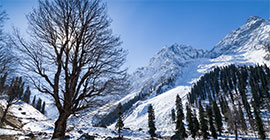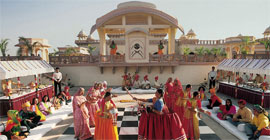aurangabad
Home | Aurangabad
Panchakki
Panchakki otherwise known as the water mill was built during the early years of the 17th century. The mill used to grind grains for the pilgrims. It was so designed that it generated energy through water which was brought from a spring on a mountain.
These pipes are lined up at particular distances. To allow the water to flow through the pumps masonary pillars are erected. Water through the pipes flows with a force and it rises to a huge raised masonary pillar and from there it falls to make an attractive water fall.
Bibi Ka Maqbara
Bibi Ka Maqbara is a magnificent mausoleum, situated at a distance of approximately 5 km from the Aurangabad city of India. It entombs Rabia-ul-Daurani, alias Dilras Banu Begum, the wife of the Mughal Emperor Aurangzeb. The construction work on the mausoleum was started in the year 1651 and it took approximately 10 years to complete it. Prince Azam Shah, the son of Aurangzeb, got the tomb built in the memory of his mother. The main entrance door of Bibi ka Makbara is adorned with an inscription.
The reason for this is that, despite the fact that it could not be an adequate competitor for the Taj, it is still a magnificent monument. Bibi Ka Maqbara has been set amidst picturesque surroundings, with the mountain ranges providing the perfect backdrop. In the center of the north, east and western part of the enclosure wall of Bibi ka Makbara, one can find pillared pavilions. Its gardens follow the typical Mughal Char-Bagh pattern in their layout, adding to the splendor of the mausoleum.
Khuldabad
Khuldabad is a very important significant religious centre. The place is abode to 2 of the most worshiped Muhammaden saints. Burhan-ud-din and Zain-ud-din are the most worshiped Muhammaden saints and their tombs are also situated here.
Khuldabad has Nagarkhana, Pangra and Langda form the three gates. The remaining four gates are Mangalpeth, Kunbi Ali, Hamdadi. The religious center also has a lattice gate called Azam Shahi. A vast tank rests to the west of the city wall and it is believed that the tank has been a major water source of the city.
Chauk Masjid
This masjid was built by Shayistakhan in 1665 A.D It has five pointed arches in front and two arches in depth. These are connected with one another by eight pillars and corresponding pilasters and support five domes. The Chauki-ki-masjid is one of the masjids and dargahs that are scattered in and around the old city of Aurangabad.
The Chauki-ki-Masjid was built by Aurangzeb's uncle. It was built by Shayista Khan who was Aurangzeb's uncle in 1665 A.D. The Chauki-ki-masjid has five pointed arches in front. It is two arches deep. The arches are connected by eight pillars. They support five domes. The central dome is elevated and has a metallic steeple. The other domes are hidden in the roof. Minarets at the corners can also be seen. The complete structure has a high basement which contains chambers. These chambers were used for shops and opens on the roadside.
Lal Masjid
The Lal Masjid was constructed in 1665 A.D by Zainul Abdin Mafti, the superintendent of building in Aurangzeb's time. It is built of basalt painted Red and is ornamented with stucco plaster.The Lal Masjid was founded in 1965, and was a religious and political center for the city's elite and government officials. The mosque was rumored to have been organized and supported by the ISI intelligence service.
During the 1980s, the mosque helped recruit fighters for the Afghan rebellion against Soviet rule. In recent years, the mosque administration has called for Islamic law (sharia) to be imposed in Islamabad.
Ghrishneshwar Temple
Ghrishneshwar Temple is a very revered temple, situated in the state of Maharashtra. It lies very near to the Buddhist caves of Ellora, only half a kilometer away, and serves as the abode of one of the 12 Jyotirlingas in India dedicated to Lord Shiva.
Grishneshwar Temple, also known as Ghushmeshwar, has a very interesting legend attached to it. It is said that there was once a very religious woman, known as Kusuma, who used to worship Lord Shiva on a daily basis. She used to immerse His Shivalingam in a tank, as a part of her everyday prayer. Her husband had a second wife, who got jealous of the devotion of Kusuma and her resultant respect in the society. In a fit of rage and resentment, she murdered Kusuma's son. Kusuma became extremely depressed when she came to know that her son had been killed. However, she continued worshipping the Lord. It is said that when she immersed the lingam into the tank, after her the death of her son, he miraculously came back to life again. The legend further goes that at that time, Lord Shiva appeared before Kusuma as well as the villagers. It is said that on Kusuma's request, Lord Shiva manifested Himself at the very site, in the form of the Jyotirlinga Ghusmeshwar.















